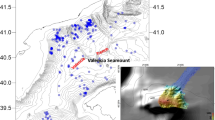Abstract
Methodological investigations, using remains of Bosminidae and Chydoridae, were undertaken to study the development of ecosystems in former river channels. Four biotopes from two former channels of different ages were used in this work. The Copepoda and Cladocera populations characterized each of the 11 sampling stations in relation to ecological factors, which are linked to the development stage in each ecosystem. Analysis of only the Bosminidae and Chydoridae populations presented practically the same information as an analysis of the total populations of Copepoda and Cladocera. The distribution of Bosminidae and Chydoridae remains taken from the surficial sediments at the deepest point of each former channel strongly resembled the distribution of the living populations sampled at several stations during one full year. Therefore, Bosminidae and Chydoridae remains could provide us with pertinent information concerning each phase of ecological succession that occurs in abandoned river channels.
Similar content being viewed by others
References
Amoros, C., 1980 (a). Structure et fonctionnement des écosystèmes du Haut-Rhône français: XV. Structure des peuplements de Cladocères et Copépodes de deux anciens méandres d'âges différents. Acta Oecol., Ecol. Gen. 1: 193–208.
Amoros, C., 1980 (b). A simple device for quantitative pseudoperiphyton sampling. Hydrobiologia 68: 243–246.
De Costa, J. J., 1964. Latitudinal distribution of chydorid Cladocera in the Mississippi Valley based on their remains in surficial lake sediments. Invest. Indiana Lakes Streams 6: 65–101.
Frey, D. G., 1958. The late glacial cladoceran fauna of a small lake. Arch. Hydrobiol. 54: 209–275.
Frey, D. G., 1959. The taxonomic and phylogentic significance of the head pores of the Chydroidae (Cladocera). Int. Revue ges. Hydrobiol. 44: 27–50.
Frey, D. G., 1960. The ecological significance of Cladoceran remains in lake sediments. Ecology 41: 684–699.
Frey, D. G., 1962. Supplement to: the taxonomic and phylogenetic significance of the head pores of the Chydoridae (Cladocera). Int. Revue ges. Hydrobiol. 47: 603–604.
Goulden, C. E. & D. G. Frey, 1963. The occurrence and significance of lateral head pores in the genusBosmina (Cladocera). Int. Revue ges. Hydrobiol. 48: 513–522.
Hofmann, W., 1980. Tierische Mikrofossilien aus Oberflächensedimenten einiger Eifelmaare. Mitt. Pollichia 68: 177–184.
Jacquet, C., C. Amoros & Y. Auda, 1984. Evolution des écosystèmes aquatiques abandonnés par les fleuves: recherches méthodologiques sur l'utilisation des restes de Cladocères en écologie rétrospective. Archiv. Hydrobiol. 102: 73–89.
Jones, G. T. & M. Tsukada, 1981. Paleoecology in the Pacific Northwest. II. Cladoceran succession. Verh. int. Ver. Limnol. 21: 738–744.
Mueller, W. P., 1964. The distribution of cladoceran remains in surficial sediments from three Northern Indiana lakes. Invest. Indiana Lakes and Streams 6: 1–63.
Murray, D. A., 1979. The evolution of pollution evidenced by lake sediment pseudofossils, p. 77–92 In: Biological aspects of freshwater pollution. Proc. course, Ispra, June 1979, Pergamon Press, New York, 214 pp.
Richardot-Coulet, M., C. Amoros, J. L. Reygrobellet & A. L. Roux, 1982. Diagnose des ensembles fonctionnels aquatiques définis sur le Haut-Rhône français. Application à une cartographie écologique d'un système fluvial. Eau du Québec 15: 146–153.
Roux, A. L. (ouvrage collectif, publié sous la direction de), 1982. Cartographie polythématique appliquée à la gestion écologique des eaux; étude d'un hydrosystème fluvial: le Haut-Rhône français. Edit. CNRS, Centre Région. Publ. Lyon, 116 pp.
Synerholm, C. C., 1979. The chydorid Cladocera from surface lake sediments in Minnesota and North Dakota (USA). Arch. Hydrobiol. 86: 137–151.
Whiteside, M. C., 1970. Danish chydorid Cladocera: modern ecology and core studies. Ecol. Monogr. 40: 79–118.
Author information
Authors and Affiliations
Rights and permissions
About this article
Cite this article
Amoros, C., Jacquet, C. The dead-arm evolution of river systems: A comparison between the information provided by living Copepoda and Cladocera populations and by Bosminidae and Chydroidae remains. Hydrobiologia 145, 333–341 (1987). https://doi.org/10.1007/BF02530295
Issue Date:
DOI: https://doi.org/10.1007/BF02530295




